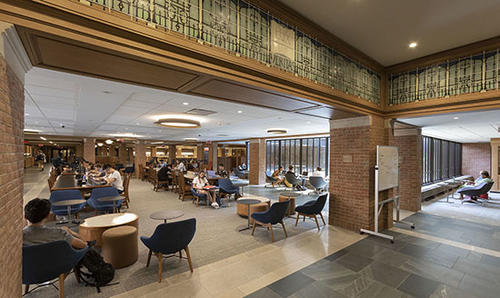
The five-month renovation of Bass Library expanded study space, added new seating configurations, and improved the flow of natural light throughout the space. The library’s print collection was consolidated on the lower level, with new collection parameters to ensure that it better supports the Yale College curriculum across all disciplines. Books removed from the Bass collection can now be found in the stack tower of the adjacent Sterling Memorial Library.
At an reopening reception on Oct. 1, Susan Gibbons, the Stephen F. Gates ’68 University Librarian, welcomed attendees, and curator Laura Wexler, Professor of American Studies and Professor of Women’s, Gender, and Sexuality Studies, introduced the first Bass Library Model Research Collection, “Find a Set, Find a Text: Read the Set Against the Text."
The model research collection is a new initiative to show the breadth and depth of resources available from Yale University Library’s many libraries, locations and collections. Another display collection in the renovated space, “Building the Bass Library Collection,” offers a window into collection development with examples of specific titles selected by subject-expert specialists.
Over the summer, a team of librarians analyzed content and usage of the Bass collection. As a result of this work, more than 35 percent of the 61,000 volumes in the post-renovation collection are new to Bass, and disciplines that were somewhat under-represented before the renovation, such as the arts, sciences, and law, have a proportionally larger presence in the new collection. Going forward, the collection will be dynamic, with up to 3,000 new titles added per year.
Opened in January 1971 as Cross Campus Library, the underground library was completely reimagined as the Anne T. and Robert M. Bass Library in 2007. Many decorative elements introduced in 2007, such as entry pavilions on Cross Campus and the tile frieze in the entrance at the end of the tunnel from Sterling Memorial Library, were designed to visually connect Bass with Sterling Library’s Gothic motifs. Wall hangings were woven to the architects’ specifications by Tibetan artisans in Nepal, with a stylized arch pattern to evoke Sterling Library’s leaded windows and metal work, and color gradations to represent a descent from sky to earth.
![]()
photos: Harold Shapiro